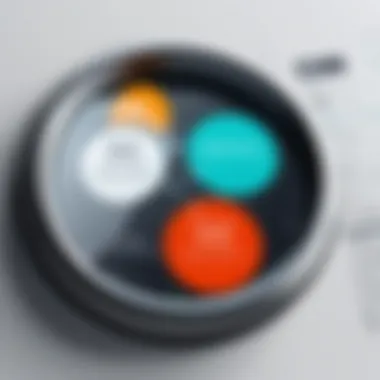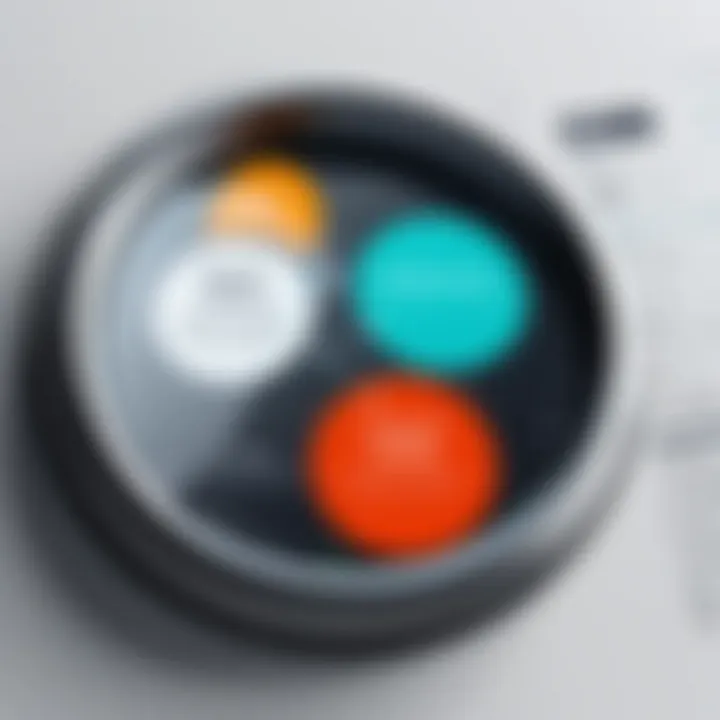Evaluating the Legitimacy of Plagiarism Checkers


Intro
In the digital age, the integrity of written content has become increasingly paramount. With the rise of the internet, the ability to access vast amounts of information has led to a surge in the incidence of plagiarism. As a result, the demand for tools that can detect and prevent plagiarism has growed significantly. This article will delve into the legitimacy of various plagiarism checkers, assessing their functionality, accuracy, and the potential legal repercussions of using such tools.
Software Category Overview
Definition and Importance
Plagiarism checkers are specialized software programs designed to identify instances of copied content. They analyze text submissions against a database of existing work to ensure originality. In academic and professional settings, these tools are vital. They help uphold academic integrity and can impact professional credibility, making it essential for users to choose the right tool.
Key Characteristics
When evaluating plagiarism detection software, several characteristics are crucial:
- Accuracy: The most important feature is the ability of the software to accurately identify copied content. Misidentification can lead to false accusations.
- Database Size: A wider database enhances the tool's capability to recognize plagiarized text. Tools with only a limited database may miss significant content.
- User Interface: An intuitive interface ensures ease of use, which is essential for those who may not have advanced technical skills.
Comparative Analysis of Top Software Options
Feature Comparison
Several popular plagiarism detection tools have made their mark in the industry, each offering unique features:
- Turnitin: Widely used in academic circles, it offers detailed reports and a vast database.
- Grammarly: While primarily a grammar-checking tool, it includes a plagiarism checker that scans web content.
- Copyscape: Known for its online-focused approach, it can detect plagiarism across websites easily.
Pricing Models
Pricing models vary significantly among different software. Here is a brief overview:
- Turnitin: Generally subscription-based and often paid by institutions rather than individual users.
- Grammarly: Offers a free version with limited features, while the premium subscription includes advanced checks and plagiarism detection.
- Copyscape: Operates on a pay-per-use basis, making it more flexible for occasional users.
Finale
The legitimacy of plagiarism checkers is largely dependent on their functionality and accuracy. In an era where content is king, utilizing effective plagiarism detection tools is not only recommended but necessary. Stakeholders must carefully consider their options to maintain integrity, whether in academic endeavors or professional writing. Evaluating these tools based on defined characteristics, features, and pricing strategies is essential for making informed decisions.
Understanding Plagiarism Checkers
Plagiarism checkers play a crucial role in maintaining academic and professional integrity. Their importance cannot be understated, especially in a world where information is readily shared and accessible. Understanding the functionality and reliability of these tools is a key aspect for any stakeholder.
A plagiarism checker aids in identifying copied content, ensuring that originality is upheld. Given the increasing emphasis on authenticity, particularly in academia and publishing, these tools have gained significant traction. Their functionality encompasses various detection methods, and an awareness of how they operate can assist users in making informed choices. Moreover, evaluating the legitimacy of these tools helps in selecting the right one that can deliver meaningful results while being affordable and efficient.
Definition of Plagiarism
Plagiarism can be defined as the act of presenting someone else's work, ideas, or expressions as one’s own, without proper acknowledgment. It can range from copying text verbatim to paraphrasing someone else's thoughts without citation. In academic circles, it is seen as a severe breach of ethics, leading to legal ramifications and potentially tarnished reputations. The various forms of plagiarism emphasize the need for reliable detection methods to navigate the complex landscape of written content.
Function of Plagiarism Checkers
Plagiarism checkers serve several integral functions. Primarily, they scan documents for similarities against a vast database of sources, including articles, books, and web pages. The aim is to identify text matches and highlight potential issues. These tools not only check for direct copying but also analyze paraphrasing.
Their effectiveness varies significantly, depending on the algorithms used and the comprehensiveness of their databases. Many tools provide a detailed report of matches, allowing users to understand the extent of the similarity.
The accuracy of these functions is essential for both academic success and professional credibility. A good plagiarism checker should minimize false positives—instances where original work is incorrectly flagged—and maximize its ability to catch actual instances of plagiarism.
As such, understanding how plagiarism checkers function will help users rely on these tools to protect their integrity and enhance their writing processes.
Types of Plagiarism Checkers
Understanding the various types of plagiarism checkers is essential for anyone wishing to navigate the complexities of academic integrity. This section aims to illuminate the differences in tools available, which can greatly influence the user experience and the effectiveness of plagiarism detection.
Free vs. Paid Services
Plagiarism checkers come in both free and paid versions. Free services can be tempting due to the absence of cost, but they might lack comprehensive features that paid services offer. Free tools often have limitations in terms of the volume of text that can be checked at one time. Moreover, they may not provide detailed reports or extensive databases to compare texts against.
Conversely, paid services usually present a more robust set of features. These tools often boast sophisticated algorithms and extensive databases, enabling them to detect even subtle forms of plagiarism. This accuracy is crucial for scholars who require thorough checking to maintain the integrity of their work. Users might find paid services more reliable because they often receive regular updates and improved functionalities over time.
Installed Software vs. Online Tools


The distinction between installed software and online tools also plays a significant role in evaluating plagiarism checkers. Installed software typically requires downloading onto one’s local device. This allows for offline use, which can be beneficial in areas with unreliable internet access. However, these programs may require maintenance and updates that can be cumbersome for users.
In contrast, online tools offer the convenience of being accessible from any device with an internet connection. They often come with user-friendly interfaces that make them easy to navigate. Additionally, online checkers usually run on powerful servers, allowing for faster analysis of larger documents. Nonetheless, users need to consider data privacy; uploading sensitive content to online platforms may raise concerns regarding confidentiality.
Evaluating the types of plagiarism checkers is an important step for decision-makers, IT professionals, and entrepreneurs alike. Understanding these variations allows stakeholders to choose a solution that aligns best with their needs.
Evaluating Validity
Criteria for a Legitimate Tool
When assessing a plagiarism detection tool, several key criteria must be put into consideration. These factors might include:
- Detection Rates: A legitimate tool should have a high rate of detection for both direct copying and paraphrased content. Look for reports that outline these rates clearly.
- Database Size: The breadth of sources a checker examines is important. A tool that indexes a wide range of databases, academic journals, and web content is more likely to provide accurate results.
- User Interface: A well-designed interface that is user-friendly can greatly enhance the usability of a plagiarism checker. Complexity can hinder effective usage.
- Reporting Features: Effective tools should provide detailed reports that break down detected similarities and their sources. This transparency allows users to assess originality better.
These criteria are not exhaustive but provide a strong foundation for evaluating any plagiarism detection tool’s legitimacy.
User Reviews and Testimonials
User reviews serve as a valuable source of insight regarding the functionality and effectiveness of plagiarism checkers. Users often share their experiences, detailing both positive aspects and frustrations they encountered. When examining testimonials, consider the following:
- Volume of Feedback: A large number of reviews usually indicates a well-adopted tool, allowing for a more comprehensive overview of its performance.
- Context of Use: Reviews often provide context such as the type of documents scanned and the target audience. Academic users may have distinct requirements compared to professional or casual writers.
- Update Responsiveness: Users often mention how regularly the tool receives updates to improve accuracy. This responsiveness can indicate a company’s commitment to maintaining its software.
While individual experiences may vary, analyzing trends in user feedback can lead to informed decisions about which tools are genuinely effective.
Industry Standards and Endorsements
Finally, industry standards and endorsements can tremendously influence the credibility of plagiarism checkers. Many educational institutions and professional organizations endorse specific tools, including:
- Accreditations: Look for endorsements from reputable academic bodies or organizations focused on educational integrity. These can increase a tool's legitimacy.
- Compliance with Standards: Tools that comply with industry standards for accuracy and data handling can be viewed as more professional and reliable.
- Partnerships: Collaborations with respected educational institutions may indicate reliability, as these entities typically conduct their own evaluations before endorsements.
"Legitimacy in plagiarism checkers not only ensures adequate content review but also supports efforts to uphold academic and professional integrity."
In summary, evaluating the validity of plagiarism checkers involves scrutinizing multiple elements ranging from technical performance to user experiences and industry credibility. This careful analysis helps stakeholders select tools that not only detect plagiarism effectively but also support the larger academic and professional narratives surrounding originality.
Functionality and Accuracy
In the realm of plagiarism detection, understanding functionality and accuracy is crucial. Functionality of a plagiarism checker refers to its ability to identify and analyze text effectively. A well-functioning tool should be able to scan documents quickly while providing comprehensive reports. Accuracy, on the other hand, is about the precision of these checks. A tool must not only flag potential issues but also do so reliably, minimizing errors that could hamper the trust in the results.
Investing in a plagiarism checker means relying on its functionality for academic integrity. Users expect a tool to deliver accurate results while minimizing the chances of false flags. Accuracy impacts not just the immediate user experience but also the overall credibility of the institution relying on these tools. Thus, functional capability and the accuracy of the software directly correlate with user trust.
Detection Algorithms Used
Detection algorithms form the backbone of how plagiarism checkers operate. These algorithms analyze textual similarities and patterns, identifying how closely one piece of writing matches another. Various algorithms exist, each with its strengths and weaknesses. Some may focus on word-for-word comparison, while others employ artificial intelligence and machine learning to interpret semantics.
Modern plagiarism checkers like Turnitin and Grammarly utilize advanced algorithms that go beyond simple text matching. They analyze context, synonyms, and even the overall structure of documents. This depth of analysis is paramount to ensure that even paraphrased or altered text can be accurately identified.
"The robustness of a plagiarism checker significantly hinges on the efficacy of its detection algorithms."
Investments into machine learning enhance these tools by enabling them to learn from vast amounts of data. As more documents are processed, these algorithms can better distinguish between original and plagiarized content, improving their capabilities over time.
False Positives and Negatives
False positives and negatives represent the two sides of error in plagiarism detection. A false positive occurs when an originality checker flags content that is actually original, creating unnecessary concern for users. Conversely, a false negative happens when the system fails to identify plagiarized content, potentially leading to ethical breaches in academic or professional settings.
Managing these errors is vital. Too many false positives can sour a user’s trust in the tool. They may start ignoring alerts, assuming incorrect warnings. Meanwhile, false negatives can critically undermine the purpose of using a plagiarism checker in the first place. If significant content evades detection, the implications for academic integrity can be severe.
To mitigate these issues, users must select tools with a reputation for low error rates. User reviews and empirical testing can often reveal the effectiveness of different tools in real-world applications. Academic institutions should also provide training on how to interpret results, emphasizing to users that not every flagged item is a problem, while also ensuring they know how to address potential issues realistically.
Legal Considerations
Copyright Issues
Copyright issues present a significant concern when utilizing plagiarism checkers. The primary reason is that these tools may analyze and store submitted content to enhance their databases. This raises questions about who owns the content once it is submitted and whether it can be used in any way by the service provider. In many jurisdictions, copyright law protects original works. Thus, if a user inadvertently submits a copyrighted material, they risk violating copyright terms unless they possess the rights to share that content.
For instance, some plagiarism checkers may retain a copy of the work for future comparison. Users should check the terms of service to understand if and how their submissions will be used. If a tool's policy allows for retention or use of submitted content without explicit consent, users could be unknowingly exposing themselves to copyright litigation. Therefore, it is essential to choose a plagiarism checker that respects copyright law, ensuring that user submissions are not misappropriated.


Data Privacy Concerns
Data privacy concerns are increasingly relevant in our data-driven world. Users of plagiarism checkers must be aware of how their data is handled and protected. When a document is uploaded, sensitive information could be exposed, including personal data or proprietary content. It is crucial for users, especially in academic or business environments, to recognize the importance of privacy policies provided by plagiarism detection services.
Many checkers claim they value user privacy, often stating that they delete documents after processing. However, such claims require scrutiny. Users should thoroughly review the privacy statements to ensure that their data is not stored, reproduced, or shared with unauthorized parties. A clear privacy policy indicates that a service prioritizes data protection, which builds trust between users and service providers.
Furthermore, GDPR and other regulations enforce stringent guidelines on how personal data is processed. Non-compliance can lead to severe penalties for both users and service providers. Users must ensure that the selected plagiarism checker is compliant with relevant laws to safeguard their data effectively.
"Your choice of plagiarism checker can impact not just academic integrity, but also legal standing in matters of copyright and data privacy."
Comparative Analysis of Popular Tools
In an era where academic integrity is paramount, understanding the various plagiarism checkers available becomes essential. Each tool on the market offers unique features and pricing models, impacting their effectiveness and adoption. Evaluating these tools rigorously allows users to choose one that aligns best with their requirements. This section aims to break down specific elements necessary for a comprehensive comparison of popular plagiarism detection tools. It highlights benefits, considerations, and criteria critical for users, assisting them in making well-informed decisions.
Feature Comparison
When comparing plagiarism checkers, it is vital to assess their features. Common features include detection capabilities, database coverage, user interface, and reporting options. The effectiveness of these tools greatly lies in their algorithms and how well they access a variety of sources.
- Detection capabilities: Tools like Turnitin and Grammarly not only identify duplicate content but also offer originality reports that explain the sources of detected matches. A wider database enhances the tool's ability to detect plagiarism across various works.
- User interface: A user-friendly interface facilitates ease of use. For instance, tools like Quetext provide an intuitive design that allows users to navigate through the functionalities with ease, crucial for first-time users.
- Reporting options: The efficacy of a plagiarism checker is also reflected in the reports generated. Some tools give detailed reports, highlighting sections of text against matched sources, while others might offer only summary statistics.
To summarize, users should prioritize features that match their specific needs. Whether one seeks comprehensive reporting or a user-friendly interface, these elements play a significant role in the tool’s overall utility.
Pricing Models
Pricing is another critical consideration when selecting a plagiarism checker. Models vary widely among tools, including subscription-based, pay-per-use, and free options.
- Subscription-based services: Tools like Turnitin and Copyscape typically operate on a subscription model, offering various packages based on features and user needs. This approach can be beneficial for individuals or organizations that require regular access to the software.
- Pay-per-use options: Some tools, such as Plagscan, offer flexibility by allowing users to pay for individual reports. This might be appealing for infrequent users who do not want to commit to a full subscription.
- Free tools: There are numerous free options, including Grammarly’s lite version. However, free tools may lack comprehensive features, making them less effective for in-depth plagiarism detection.
When assessing pricing, users should consider not only the cost but also the value received in terms of features and support. While a low price is attractive, it should not compromise a tool’s reliability or accuracy.
Takeaway: Evaluating features and pricing models is imperative in choosing the right plagiarism checker, ensuring that users find the tool that best fits their specific needs.
User Experience
User experience plays a critical role in the effectiveness of plagiarism checkers. The design and ease of use of these tools can significantly impact their adoption and overall utility. For decision-makers and IT professionals, understanding the user experience can guide choice in selecting a tool that not only performs well but also integrates smoothly into existing workflows.
Plagiarism checkers should prioritize clean interfaces and intuitive navigation. Users benefit from clearly labeled features and easy access to reports. An efficient user experience reduces the time needed to understand how to utilize the software, allowing users to focus on the task at hand rather than the tool itself. Key aspects of user experience include interactivity, usability, and support resources.
"A tool that is difficult to use, regardless of its effectiveness, may lead to frustration, ultimately affecting user trust and reliance on the product."
Interactivity and Usability
Interactivity directly connects users to the functionality of plagiarism checkers. Effective tools allow users to upload documents quickly, providing instant feedback or reports on content originality. Features such as drag-and-drop file uploads, real-time scanning, and comprehensive dashboards enhance interactivity.
Usability, on the other hand, pertains to how intuitively a user can navigate the system. An ideal plagiarism checker should present results in an accessible format. Visual aids, such as color coding for varying levels of originality, assist in immediate comprehension of the analysis. Speed and performance are also significant; a user-friendly check tool should not exhibit delays during document processing. This will keep the workflow uninterrupted, a vital aspect for professionals who operate under tight deadlines.
Support and Resources Available
Support mechanisms are essential in fostering a positive user experience. Comprehensive user guides, FAQs, and troubleshooting materials can empower users to resolve issues independently. Additionally, access to live chat support or dedicated customer service representatives is invaluable, especially for users facing technical challenges.
Resources should not only assist with immediate problems but also aid users in maximizing the software’s capabilities. Tutorials or demos that showcase advanced features can significantly enhance user knowledge, encouraging users to explore the full potential of the tool.
Moreover, an active community around the plagiarism checker can provide peer support and shared insights. User forums or discussions on platforms like Reddit can be beneficial. Users sharing experiences and solutions can increase overall satisfaction and efficiency when using the checker.
Building Knowledge and Awareness
Building knowledge and awareness regarding plagiarism is essential in today’s academic and professional landscape. Understanding the nuances of plagiarism, including its various forms and implications, is crucial. Plagiarism is not merely about copying another's work; it can manifest in subtle ways, such as paraphrasing without proper citation or using an idea without acknowledgment. This awareness establishes a foundation for ethical conduct in writing and research, critical for maintaining integrity.
Moreover, plagiarism checkers play a significant role in fostering this knowledge. They help users discern the difference between acceptable use and inappropriate copying, thus enhancing their understanding. A well-informed user is less likely to commit unintentional plagiarism, which can have serious consequences, including reputational damage and academic penalties.
The benefits of building this knowledge extend beyond individual practices. When a community, whether academic or professional, is educated about proper citation and the use of plagiarism detection tools, it contributes to a culture of integrity. This culture not only promotes ethical writing but also encourages original thought and scholarly engagement.
Understanding Plagiarism Academic Culture
Plagiarism has a distinctive academic culture associated with it. In educational institutions, the expectations surrounding original work are clear. However, the understanding of what constitutes plagiarism can vary among disciplines. Different fields may have distinct citation styles and norms regarding collaboration. Thus, students and researchers must be acquainted with their specific academic expectations to avoid pitfalls.


Educational institutions often emphasize academic integrity through policies and guidelines. This cultural aspect shapes how students approach their writing and research. Engaging with this culture influences how emerging scholars perceive authorship and collaboration. By cultivating an environment where knowledge about plagiarism is widespread, institutions can help students navigate these complexities responsibly.
Educational Institutions’ Roles
Educational institutions play a pivotal role in instilling awareness about plagiarism and its implications. They are tasked with not only developing curricula that incorporate integrity but also engaging students in discussions about ethical writing practices. Through workshops, orientation sessions, and written policies, schools and universities can provide invaluable resources.
Additionally, institutions can leverage technology by integrating plagiarism detection tools into their academic processes. By requiring submissions through plagiarism checkers, they foster a proactive approach to learning about citation practices. This also serves to reduce instances of plagiarism and enhances overall academic standards.
Moreover, institutions must remain vigilant and responsive to the evolving landscape of plagiarism, particularly as digital content becomes increasingly accessible. Understanding how to utilize plagiarism checkers effectively while upholding academic integrity standards is essential for both educators and students.
"Education is the most powerful weapon which you can use to change the world." - Nelson Mandela
In summary, the role of educational institutions is paramount in building knowledge and awareness around plagiarism. They serve as the guiding force in shaping how individuals engage with their work and the works of others with respect to originality and ethics.
Recommendations for Best Practices
Choosing an effective plagiarism checker is a nuanced process that requires careful consideration. Recommendations for best practices serve as a guide to navigate this complex landscape. A well-informed choice can significantly impact the integrity of academic and professional work.
Plagiarism checkers can vary widely in functionality, accuracy, and legal standing. Understanding the characteristics of these tools is paramount. Users should look for tools that have established credibility through user testimonials and endorsements in academic environments. A robust plagiarism checker not only detects but also analyzes the context in which potential plagiarism occurs. This dual function enhances the user’s ability to learn from their mistakes, thereby fostering academic integrity.
How to Choose a Plagiarism Checker
When selecting a plagiarism checker, several factors warrant careful assessment:
- Accuracy: It is essential to choose a tool that employs advanced algorithms to minimize false positives and negatives. Some checkers, like Turnitin, have built a reputation based on their accuracy in flagging copied content.
- Database Size: The effectiveness of a plagiarism checker often depends on the breadth of its database. A larger database increases the likelihood of detecting similarities.
- User Interface: An intuitive interface can significantly improve usability. Users should favor tools that are easy to navigate and provide clear report formats.
- Customer Support: Adequate support channels are vital. Whether through live chat, email, or user forums, a responsive support system adds value to the user experience.
It is also beneficial to read user reviews on platforms such as Reddit or user experience sites. Gathering various perspectives can illuminate potential shortcomings or strengths that may not be immediately apparent.
Integrating Plagiarism Checkers into Workflow
Integrating plagiarism checkers into existing workflows enhances content quality and compliance with academic standards. Here are some effective methods for doing so:
- Early Detection: Employ the plagiarism checker in the early stages of writing. This practice allows writers to correct issues before final submission, saving time and ensuring original content.
- Regular Use for Team Collaboration: In collaborative environments, frequent use of plagiarism detection tools helps maintain integrity across contributions. This approach prevents inadvertent similarities and fosters a culture of originality.
- Feedback Mechanism: Use the feedback from plagiarism reports to educate writers. Highlight areas for improvement and encourage the development of proper citation practices.
Implementing these practices can promote a proactive stance on plagiarism prevention. By integrating plagiarism checkers into everyday tasks, organizations can cultivate a standard of quality and ethical content creation.
Future Developments
The ever-changing nature of technology has a significant impact on plagiarism checkers. The topic of future developments is crucial in understanding how these tools will evolve to meet the challenges of academic integrity and content creation. As writers and educators continue to confront issues related to plagiarism, advancements in technology promise to provide improved detection capabilities and better user experiences. Knowing what the future holds allows stakeholders to make informed choices about the tools they use.
Advancements in Technology
Technology continues to shape the tools used for detecting plagiarism. Innovations in artificial intelligence and machine learning have transformed how plagiarism checkers function. These advancements enable more sophisticated analysis of text, identifying not only direct copying but also more complex forms of plagiarism, such as paraphrasing and syntactic alterations.
- Smart Algorithms: New algorithms now utilize natural language processing techniques to evaluate the context of phrases. This allows tools to differentiate between common knowledge and original content, reducing false positives significantly.
- Real-Time Detection: Advanced tools offer real-time feedback, allowing users to receive immediate results. This not only enhances the user experience but also fosters a more proactive approach to academic integrity, as users can modify their work instantly based on the feedback provided.
- Integration with Writing Software: Increasingly, plagiarism checkers are integrating with word processors, software like Microsoft Word and Google Docs. This integration simplifies the editing process and helps to ensure that texts are original before submission.
The continuous improvement in technology brings significant benefits, making plagiarism checkers more essential than ever in maintaining academic honesty and integrity.
Changing Landscape of Academic Integrity
As technology evolves, so does the dialogue surrounding academic integrity. Institutions and organizations are increasingly aware of plagiarism’s implications on education and research. This shift is prompting a reassessment of how plagiarism checkers can better support the academic community.
- Policy Development: Educational institutions are creating comprehensive policies that address plagiarism, integrating the use of checkers within curriculum guidelines. This is an essential step toward standardizing academic integrity practices across various fields.
- Awareness Campaigns: The changing landscape calls for enhanced awareness campaigns aimed at students. Understanding the consequences of plagiarism is vital, and plagiarism checkers can be used as educational tools to reinforce the importance of originality in scholarly work.
- Cross-Disciplinary Collaborations: There is growing recognition of the need for collaboration across disciplines. Engaging stakeholders, such as educators, tech developers, and students, can lead to even more effective approaches in combating plagiarism.
As the academic environment transforms, it is imperative that plagiarism detection tools advance in step, ensuring that they are tools for education rather than merely enforcement mechanisms.
End
The conclusion of this article serves a vital role in underscoring the significance of assessing plagiarism checkers. It encapsulates the essence of the preceding discussions, weaving together the threads of functionality, accuracy, and legal considerations that dominate the landscape of plagiarism detection tools. In an era where academic and professional integrity are paramount, understanding which tools truly offer reliable results can shape the credibility of both individuals and institutions.
Summarizing Key Findings
In summarizing the findings, we must reflect on several critical points:
- Varied Tools Available: The market offers a broad spectrum of plagiarism checkers, each differing in algorithms, features, and pricing models. Understanding these differences helps users select tools that best fit their needs.
- User Experience Influences Effectiveness: Ease of use and the interactivity of the tools can significantly impact how well users are able to leverage these systems. A complicated interface can deter proper usage and diminish the effectiveness of the tool.
- Legal Considerations Are Crucial: Users must remain cognizant of copyright and data privacy issues. Legitimate tools should prioritize user data security and comply with relevant legal frameworks to maintain user trust.
- Industry Standards Matter: Tools that meet or exceed industry standards gain greater credibility. Endorsements and validation from educational institutions can also bolster the legitimacy of a plagiarism checker.
"Evaluating the legitimacy of a plagiarism checker goes beyond merely relying on algorithms; it encompasses various factors that collectively inform the user's decision-making process."
Final Thoughts on Legitimacy
This article underscores that legitimacy in plagiarism checkers cannot be taken at face value. Users must engage in thorough evaluation based on functionality, specificity of detection methods, and the legal landscape surrounding each tool. As technology advances, the effectiveness of plagiarism detection tools will most likely evolve, further complicating the decision-making process. Stakeholders, including educators, students, and businesses, should continuously update their knowledge to navigate this ever-changing environment effectively.
Ultimately, the legitimacy of plagiarism checkers is intertwined with the broader quest for integrity in academic and professional realms. Informed choices can foster an environment where originality is valued, and plagiarism is actively deterred.







